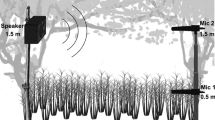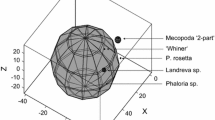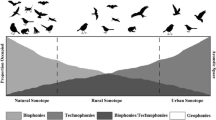Summary
-
1.
Acoustic communication requires not only detection of the signal but also discrimination of differences among signals by the receiver. Attenuation and degradation of acoustic signals during transmission through the atmosphere will impose limits on acoustic communication. Attenuation of sound during atmospheric transmission results primarily from atmospheric absorption, ground attenuation, scattering of a sound beam, and deflection of sound by stratified media. For maximum range of detection, therefore, animals should favor optimal positions in their habitat and optimal weather conditions. Frequency-dependent attenuation seems not to differ consistently among major classes of terrestrial habitats, such as forests and fields. Increased scattering of higher frequencies from vegetation in forests is in part matched by scattering from micrometerological heterogeneities in the open.
-
2.
In addition to frequency-dependent attenuation, two kinds of degradation during atmospheric transmission will limit a receiver's ability to resolve differences among acoustic signals: the accumulation of irregular amplitude fluctuations from nonstationary heterogeneities, often atmospheric turbulence, and reverberation. Both types of degradation affect temporal patterns of amplitude or intensity modulation more than patterns of frequency modulation. Both effects should increase with carrier frequency, as they depend on the relationship between wavelength and the dimensions of scattering heterogeneities. Irregular amplitude fluctuations are more severe in open habitats and primarily mask low frequencies of amplitude modulation; reverberations are more severe in forested habitats and primarily mask high frequencies of amplitude modulation and rapid, repetitive frequency modulation. This difference between forested and open habitats could explain previous reports that birds in the undergrowth of tropical forests avoid rapid frequency modulation in their long-range vocalizations.
-
3.
Maximum range of detection is probably not the primary selection pressure on many animal vocalizations, even for territorial advertisement, except perhaps in tropical forests. Instead, acoustic signals might incorporate features that degrade predictably with range to permit a receiver to estimate the signaler's distance. Future investigations might explore the propagation of animal vocalizations in relation to the usual spacing of animals in their habitat. Features that encode different kinds of information, such as individual and species identity, might propagate to different distances.
-
4.
Measurements of the transmission of sound in natural environments have often not controlled several important parameters. First, the effects of gound attenuation and scattering are not linear with range; consequently measurements of excess attenuation over different ranges in the same environment might differ. Second, the directionality of speakers and microphones will affect measurements of attenuation and reverberations in scattering environments. Third, as stationary waves shift with frequency, any single microphone placement will lie in a null for some frequencies and in a maximum for others.
Similar content being viewed by others
References
Alexander, R.D.: Acoustical communication in arthropods. Ann. Rev. Entomol. 12, 495–526 (1967)
Altmann, S.A.: The structure of primate social communication. In: Social communication among primates (ed. S.A. Altmann), pp. 325–362. Chicago: Univ. Chicago Press 1967
Aylor, D.: Noise reduction by vegetation and ground. J. acoust. Soc. Amer. 51, 197–205 (1971)
Baynton, H.: The penetration and diffusion of a fine aerosol in a tropical rain forest. Unpublished Ph.D. dissertation. University of Michigan (1963)
Beranek, L.L. (ed.): Noise and vibration control. New York: McGraw-Hill 1971
Chappuis, C.: Un exemple de l'influence du milieu sur les émissions vocales des oiseaux: l'évolution des chants en forêt équatoriale. Terre et Vie 118, 183–202 (1971)
Chernov, L.A.: Wave propagation in a random medium. New York: McGraw-Hill 1960
Cherry, C.: On human communication. Cambridge: M.I.T. Press 1966
Dumortier, B.: The physical characteristics of sound emission in Arthropoda. In: Acoustic behavior of animals (ed. Busnel). Amsterdam: Elsevier 1963
Embleton, T.F.W.: Sound propagation in homogeneous deciduous evergreen woods. J. acoust. Soc. Amer. 35, 119–1125 (1963)
Eyring, C.F.: Jungle acoustics. J. acoust. Soc. Amer. 18, 257–270 (1946)
Geiger, R.: The climate near the ground. Cambridge: Harvard University Press 1950
Gerber, S.E.: Auditory temporality. In: Introduction hearing science (ed. S.E. Gerber), Chapter 8. Philadelphia: Saunders 1974
Givens, M.P., Nyborg, W.L., Schilling, H.K.: Theory of the propagation of sound in scattering and absorbing media. J. acoust. Soc. Amer. 18, 284–295 (1946)
Griffin, D.R.: The importance of atmospheric attenuation for the echolocation of bats (Chiroptera). Anim. Behav. 19, 55–61 (1971)
Gulick, W.L.: Hearing: physiology and psychophysics. New York: Wiley 1971
Haddow, A.J., Corbet, P.S.: Entomological studies from a high tower in Mpanga Forest, Uganda. II. Observations on certain environmental factors at different levels. Trans. roy. ent. Soc. Lond. 113, 257–269 (1961)
Haddow, A.J., Gillett, J.B., Highton, R.B.: The mosquitoes of Bwamba County, Uganda. V. The vertical distribution and biting cycle of mosquitoes in rain forest with further observations on microclimate. Bull. ent. Res. 37, 301–330 (1947)
Heckert, L.: Die klimatischen Verhältnisse in Laubwäldern. Z. Meteor. 13, 211–223 (1959)
Ingard, U.: On the reflection of a spherical sound wave from an infinite plane. J. acoust. Soc. Amer. 23, 329–335 (1951)
Ingard, U.: A review of the influence of meteorological conditions on sound propagation. J. acoust. Soc. Amer. 25, 405–411 (1953)
Jilka, A., Leisler, B.: Die Einpassung dreier Rohrsängerarten (Acrocephalus schoenobaenus, A. scirpaceus, A. arundinaceus) in ihre Lebensräume in Bezug auf das Frequenzspektrum ihrer Reviergesänge. J. Orn. 115, 192–212 (1974)
Kinsler, L.E., Frey, A.R.: Fundamentals of acoustics, 2nd ed. New York: Wiley 1962
Klopfer, P., Hatch, J.J.: Experimental considerations. In: Animal communication (ed. T.A. Sebeok), pp. 31–43. Bloomington: Indiana University Press 1968
Knudsen, V.O.: The propagation of sound in the atmosphere-attenuation and fluctuations. J. acoust. Soc. Amer. 18, 90–96 (1946)
Konishi, M.: Locatable and nonlocatable acoustic signals for barn owls. Amer. Nat. 107, 775–785 (1973)
Linskens, H.F., Martens, M.J.M., Hendricksen, H.J.G.M., Roestenberg-Sinnige, A.M., Brouwers, W.A.J.M., van der Staak, A.L.H.C., Strik-Jansen, A.M.J.: The acoustic climate of plant communities. Oecologia (Berl.) 23, 165–177 (1976)
Littler, T.S.: Physics of the ear. London: Pergamon 1965
Lyon, R.H.: Propagation of environmental noise. Science 179, 1083–1090 (1973)
Marler, P.: Colobus guereza: territoriality and group composition. Science 163, 93–95 (1969)
Marler, P.: Vocalizations of East African monkeys. II. Black and white colobus. Behaviour 42, 175–197 (1972)
Marler, P.: A comparison of vocalizations of red-tailed monkeys and blue monkeys, Cercopithecus ascanius and C. mitis, in Uganda. Z. Tierpsychol. 33, 223–247 (1973)
Marten, K., Marler, P.: Sound transmission and its significance for animal vocalization. I. Temperate habitats. Behav. Ecol. Sociobiol. 2, 271–290 (1977)
Marten, K., Quine, D., Marler, P.: Sound transmission and its significance for animal vocalization. II. Tropical forest habitats. Behav. Ecol. Sociobiol. 2, 291–302 (1977)
Michelsen, A., and Nocke, H.: Biophysical aspects of sound communication in insects. Advanc. Insect Physiol. 10, 247–296 (1974)
Morse, P.M., Ingard, K.U.: Theoretical acoustics. New York: McGraw-Hill 1968
Morton, E.S.: Ecological sources of selection on avian sounds. Ph.D. dissertation, Yale University 1970
Morton, E.S.: Ecological sources of selection on avian sounds. Amer. Nat. 109, 17–34 (1975)
Peterson, A.P.G., Gross, Jr., E.E.: Handbook of noise measurement, 7th ed. Concord, Mass.: General Radio Co. 1974
Pridmore-Brown, D.C., Ingard, U.: Sound propagation into the shadow zone in a temperaturestratified atmosphere above a plane boundary. J. acoust. Soc. Amer. 27, 36–42 (1955)
Raisbeck, G.: Information theory. Cambridge: M.I.T. Press 1963
Richards, P.W.: The tropical rain forest. Cambridge: Cambridge University Press 1952
Richardson, E.G.: The fine structure of atmospheric turbulence in relation to the propagation of sound over the ground. Proc. roy. Soc. Lond. A 203, 149–164 (1950)
Rudnick, I.: Fluctuations in intensity of an acoustic wave transmitted through a turbulent heated lamina. J. acoust. Soc. Amer. 19, 202–204 (1941)
Schaller, G.B.: The serengeti lion. Chicago: Univ. of Chicago Press 1972
Schleidt, W.M.: Tonic communication: continual effects of discrete signs in animal communication systems. J. theor. Biol. 42, 359–386 (1973)
Schwartzkopff, J.: Mechanoreception. In: The physiology of Insecta (ed. M. Rockstein), pp. 273–352. New York: Academic 1974
Shannon, C.E., Weaver, W.: The mathematical theory of communication. Urbana: University illinois Press 1949
Tolstoy, I., Clay, C.S.: Ocean acoustics. New York: McGraw-Hill 1966
Waser, P., Waser, M.S.: Experimental studies of primate vocalization: specializations for long-distance propagation. Z. Tierpsychol. 43, 239–263 (1977)
White, S.J., White, R.E.C.: Individual voice production in gannets. Behaviour 37, 40–54 (1970)
Wiener, F.M., Keast, D.N.: Experimental study of the propagation of sound over ground. J. acoust. Soc. Amer. 31, 724–733 (1959)
Wiley, R.H.: Communication and spatial relationships in a colony of common grackles. Anim. Behav. 24, 570–584 (1976)
Wood, A.B.: Acoustics. New York: Dover 1966
Author information
Authors and Affiliations
Rights and permissions
About this article
Cite this article
Wiley, R.H., Richards, D.G. Physical constraints on acoustic communication in the atmosphere: Implications for the evolution of animal vocalizations. Behav Ecol Sociobiol 3, 69–94 (1978). https://doi.org/10.1007/BF00300047
Received:
Issue Date:
DOI: https://doi.org/10.1007/BF00300047




